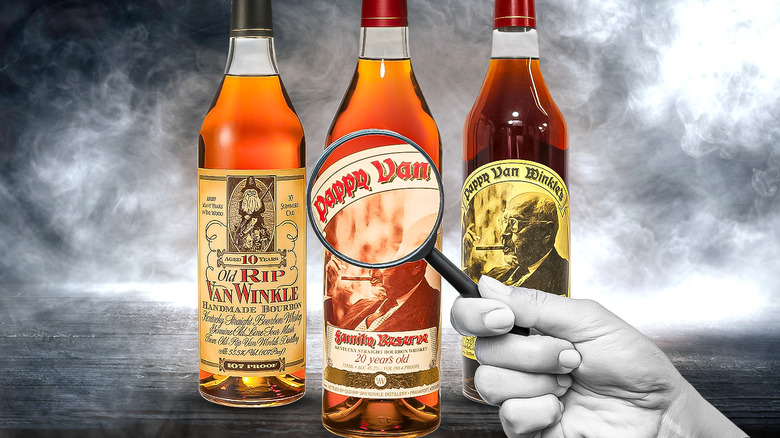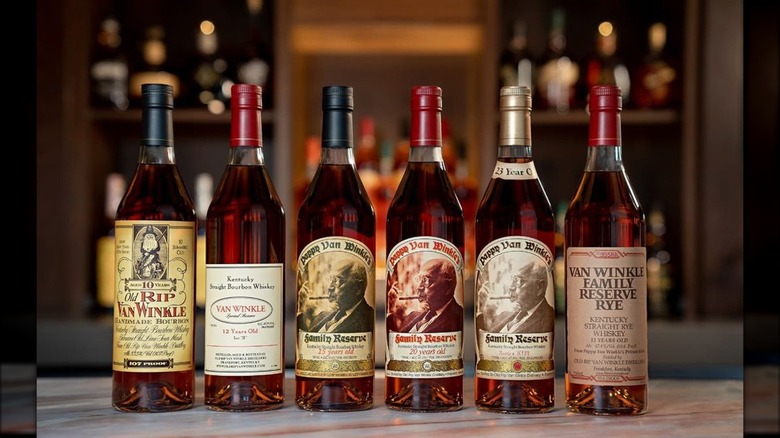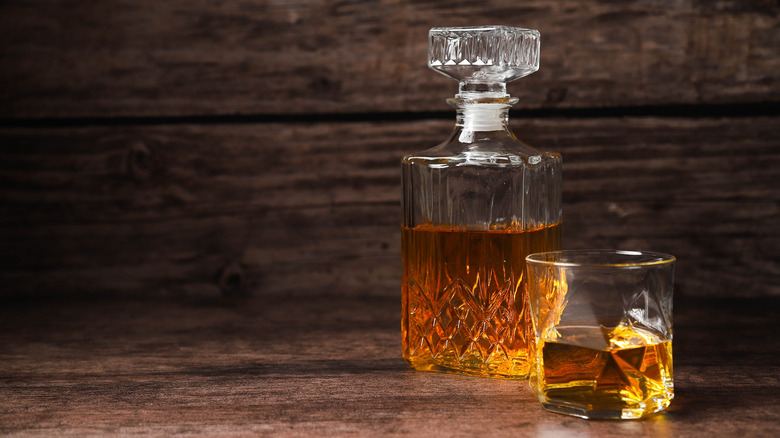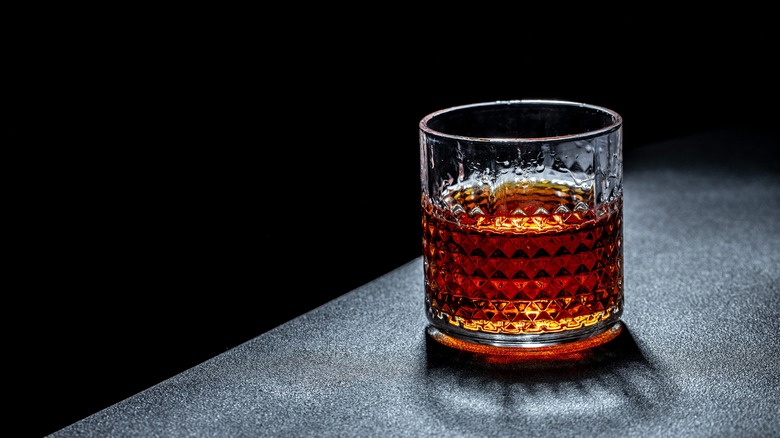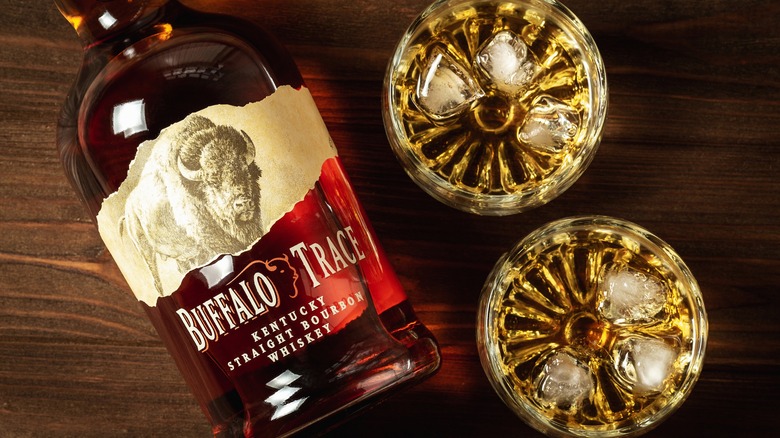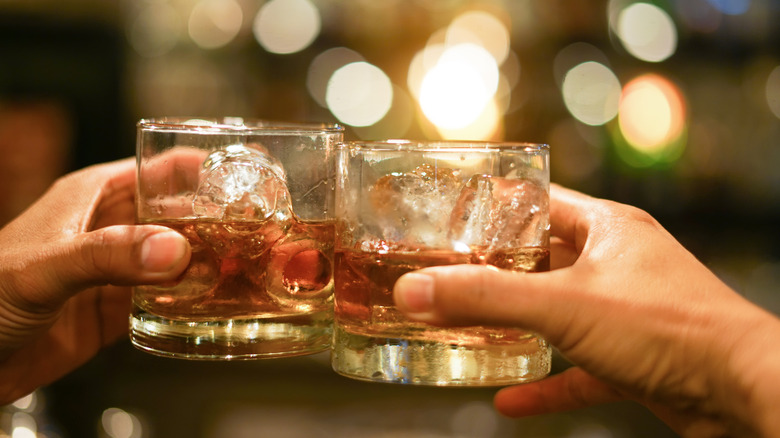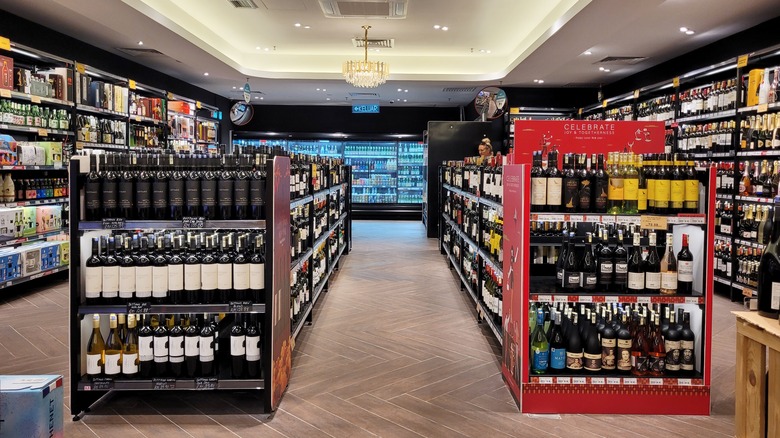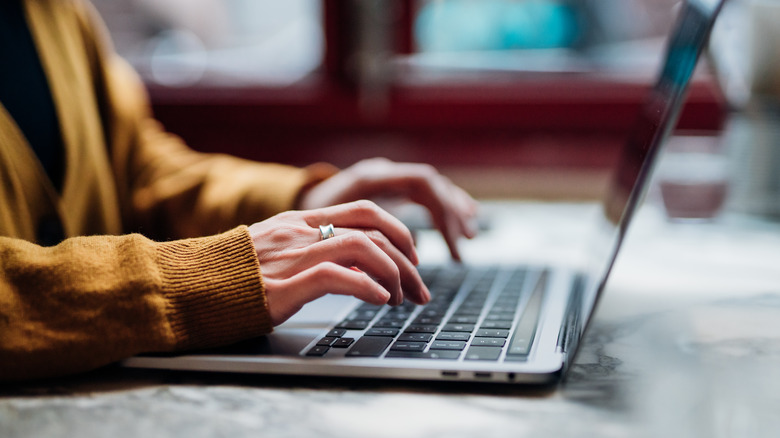Ways To Spot A Fake Pappy Van Winkle Bourbon, According To Buffalo Trace
So, you've finally found it: A bottle of the most sought-after bourbon on the market, Pappy Van Winkle. If you've been trying to get your hands on this bourbon, you probably already know that it's aged longer than most other bourbons, which means there's a highly limited amount available on the market. Though it's every bourbon lover's dream to get a taste of Buffalo Distillery's prize liquor, many of them won't get the chance. But what happens when you finally stumble across a new shop with the precious bottle in stock? What about when you finally find the liquor listing of your dreams online? Maybe you buy it, bring it home, and eagerly give it a taste test. Most likely, you'll finish the entire bottle without even realizing you've been sold a fake.
Because Pappy Van Winkle is so rare, it's no surprise that there's a massive secondary market for the bourbon brand. The most expensive bottle ever sold was $52,500 at auction. Because the fakes can sell for such high prices, they're also incredibly convincing — often going so far as to use authentic Pappy Van Winkle bottles but replacing the bourbon inside before they're sold.
If you want to learn how to spot a fake, what better way to do it than by talking to the folks at Pappy Van Winkle? We spoke with Andrew Duncan, the Global Brand Director at Buffalo Trace Distillery. Here are his top tips for spotting a fake Pappy Van Winkle bourbon.
Your bottle came from an unauthorized seller
If you're desperate to get your hands on a limited-edition Pappy Van Winkle but realize they're all sold out at your local liquor store, you might be tempted to continue the hunt online instead. But this is a big mistake when it comes to bourbon: secondary markets are practically guaranteed to be selling fake bottles. "We strongly advise against buying from anyone in the secondary market, which includes online private sellers or in social media groups that claim to offer genuine products," says Andrew Duncan. "This also includes websites like Craigslist, Facebook, and eBay." Sites like these are notorious for scam Pappy Van Winkle listings — with no one to verify the legitimacy of the bottle, it's easy for sellers to get away with fraud.
Additionally, Duncan notes that online websites cannot legally ship alcohol to most areas in the U.S. If you're trying to purchase a bottle of Pappy Van Winkle online in the U.S., well, that's your first sign that you're not working with a legitimate seller. "If you live in one of the 44 states where shipping alcohol directly to your home is illegal, and a website claims it will process your order and ship it to your state, you are most likely being scammed with a fake Pappy Van Winkle bottle," cautions Duncan.
Know what a true Pappy Van Winkle bottle looks like
When it comes to reselling Pappy Van Winkle, most resellers aren't creating their own bottles and labels; they're using empty Pappy Van Winkle bottles. The sellers will refill the empty bottles with inauthentic bourbon and seal them back up, making it very difficult for buyers to distinguish between a real Pappy Van Winkle and a counterfeit bottle. But that doesn't mean the bottle itself can't still help you determine the authenticity of a Pappy Van Winkle before you purchase it.
Before you buy a bottle of Pappy Van Winkle, you should get to know what the authentic bottles are supposed to look like. "A clear sign of fraud is a Pappy Van Winkle bottle without a matching face label and capsule on top with the proper corresponding color," says Andrew Duncan. The presence of matching capsules and face labels still can't guarantee authenticity, but if your bottle has both, you might just be one step closer to determining if your bottle is legitimate. Capsules especially can be major tells for sellers who aren't able to apply original or matching Pappy Van Winkle capsules when resealing the bottle — but we can't stress enough that these fakes are highly convincing, so don't stop at just the look when it comes to examining your bottle.
Look for imperfections
When you're inspecting a Pappy Van Winkle bottle, you should look for a few key mistakes resellers might make when resealing old bottles. You can first look towards the capsule at the top of the bottle itself to determine if the bottle may have been tampered with. "The seal should show intact perforations, and the small pull tab should be somewhat difficult to separate from the bottle at first," says Andrew Duncan.
There are a few more imperfections you should look for when it comes to spotting a fake Pappy Van Winkle. "While some imperfections do happen on the manufacturing line, dead giveaways like heavy foil wrinkling, 'banding' effects on the wrap, and severely misaligned foil are all signs of tampering. It also should not have any printing, embossing, or decoration on the foil," Duncan adds. As Duncan mentions, not every imperfection is a sign that you've accidentally purchased a fake Pappy Van Winkle. But you should look at potential errors on a bottle to determine whether or not they really could have happened during the manufacturing process or if it's more likely that they're a result of a reseller tampering with the bottle before you purchased it.
Duncan also notes that resellers can reapply foil to Pappy Van Winkle bottles even after they've been opened, and this reapplication process can make the tampered bottles look convincingly unopened. Even if your bottle's foil looks real, there's still potential for the bottle to be a fake.
Compare your bottle's lot codes
Another way you can check the authenticity of your Pappy Van Winkle is by checking the lot code. The lot code is a small code lasered onto all Pappy Van Winkle bottles. "Lot codes denote the original year the bottle was produced," says Andrew Duncan. With these, you can determine whether or not the Pappy Van Winkle listing you're looking at matches up with the actual bottle. "If you're being told it's a 2023 bottling and the lot code signifies 2020, it's likely a fake," adds Duncan.
Keep in mind that the lot code on your bottle doesn't need to be unique in order for your bottle to be legitimate. There are batches of Pappy Van Winkle bottles with the same lot codes because they're there for the producer and purchaser to know when the bottle was originally sealed. When bottles of Pappy Van Winkle are sealed at the same time, they'll all feature the same lot code.
Believe it or not, the absence of a lot code doesn't necessarily mean the Pappy Van Winkle you're looking at is fake. There can sometimes be errors in the lot codes that cause some batches to be released without lot codes at all. But it's also important to note that the mere presence of a lot code doesn't mean the bourbon you're purchasing is authentic. "The only guarantee is to have purchased from a licensed retailer," warns Duncan.
Try to taste the difference
One thing many Pappy Van Winkle buyers wonder is whether or not they'll be able to taste when something is off with the bourbon they've purchased. Unfortunately, this isn't necessarily the case. Andrew Duncan does have a few things you can look out for taste-wise, though: "Taste profiles vary based on expression and bottling year, but Pappy Van Winkle expressions are aged an extended time have an elegant, sweet aroma with bold flavor notes of caramel corn, vanilla, leather, oak, and complex fruitiness. If you're an experienced bourbon drinker and detect 'off' or 'young' notes, that could be a strong sign it's a fake," says Duncan.
Determining whether or not your Pappy Van Winkle is a fake by taste alone isn't something even many experienced bourbon fans have been able to do. This is just another reason why counterfeit Pappy Van Winkles are so common — you can't expect yourself to be able to recognize the difference in taste most of the time. Those who are familiar with the typical taste of a Pappy Van Winkle bourbon might have more luck determining when something doesn't taste right. So, if you notice your bourbon tasting a little off, chances are you might not be drinking an authentic Pappy Van Winkle.
Know your liquor retailer well
There are a lot of steps you can take to assure yourself that the Pappy Van Winkle purchase you're about to make is legitimate — but only one of them is 100% foolproof. The most important thing you can do to avoid accidentally purchasing a fake Pappy Van Winkle is to purchase your bourbon from a licensed liquor retailer. "We encourage Pappy Van Winkle bourbon fans to develop a close relationship with their favorite liquor retailer," advises Andrew Duncan. "Feel free to ask retailers where they received their bottles of Pappy Van Winkle. If that retailer received a bottle of Pappy Van Winkle from the secondary market, you, as the customer, have every right to reconsider purchasing that bottle."
In the past, some liquor retailers have come under fire for sourcing their Pappy Van Winkle bourbons from secondary market themselves. Finding a reputable liquor shop who can tell you exactly where they've purchased their Pappy Van Winkle bourbon is the only way you can completely guarantee you've bought an authentic Pappy Van Winkle. The same thing is true if you're planning on purchasing Pappy Van Winkle from a restaurant or bar.
So, what path does Pappy Van Winkle take to get from Buffalo Trace Distillery to a legitimate seller? Duncan has the official answer: "All Old Rip Van Winkle Distillery whiskeys are channeled directly through authorized Sazerac distributors to licensed stores, bars, and restaurants."
Report fraudulent listings
So, what happens if you think you've purchased a fake Pappy Van Winkle? As devastating as the realization may be, there are a few steps you can take to protect yourself. First, you should report the listing to the website you ordered it from. "As with any commerce platform, do report sellers who violate the given platform's terms of use," says Andrew Duncan.
Duncan also recommends reporting the counterfeit. "If you are concerned that you received a counterfeit bottle of Pappy, we encourage you to report where you received the bottle to the Better Business Bureau, your state's Attorney General's Office, and contact your credit card company about its fraud protection policies," Duncan adds. Depending on your card's policies, you may also be able to issue a chargeback against the seller. Not only can this help you get your money back, it can also help provide evidence towards sellers being banned from secondary-market websites.
Smash your bottles after finishing them to prevent future scams
Once you've gotten your hands on a bottle of Pappy Van Winkle, there's another step you can take to help prevent others from being scammed in the future. Whether you've purchased a counterfeit bottle or a legitimate bottle of Pappy Van Winkle, always be sure to completely dispose of your bottles after finishing them — unless you're planning on keeping them for display purposes, of course.
Many Pappy Van Winkle buyers promote the practice of carefully and safely breaking Pappy Van Winkle bottles before disposing of them. Buffalo Trace Distillery asks buyers to take similar precautions before throwing out their bottles: "If not being used for your own display or crafting for your own home, we suggest scoring or marring the label and recycling the glass," says Andrew Duncan. This prevents others from finding the bottles and using them to counterfeit Pappy Van Winkle bourbon later on.
